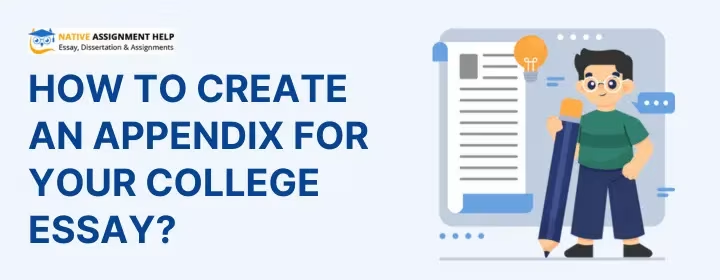Introduction
An appendix is a piece of information which might not be important to present with the main information but contains helpful insights which can help the reader get a more comprehensive idea about what they are reading. Appendices are mainly written by students in their academic writing tasks, such as research papers, essays, assignments, etc. It plays a major role in boosting the academic percentage of students, as it represents their writing, research, critical thinking and creativity skills.
The main purpose of adding a good appendix is to facilitate the reader's knowledge in understanding the complex issues in brief. It provides information which reinforces your research without disturbing the chronology of your main study. Due to this, many students who do not possess the right or sufficient skills suffer during their academics. Are you also the one out of the hundreds of students who lag in writing a good appendix? No worries; this blog is the right place to stand with your worries and take a sigh of relief from them.
Now, uncover the essentials of writing a worthwhile appendix for your college essay with this expert guide.
What is an Appendix?
In academics, an appendix is a piece of paper containing briefly explained information about the research and findings of the essay. It is inserted at the end of the essay after the reference list containing the essential raw information, such as charts, interviews, transcripts, etc. Appendices may contain some information which can be cumbersome to write in the main body. The main purpose of adding appendices is that some topics contain too long and detailed information, which may not be possible to add in the main body. This information is considered to be relevant and helpful and should be mentioned for better conceptual understanding.
When to Include an Appendix
Appendices are mainly written by academic authors or writers to employ them in published research papers, essays, articles, etc. They use them to create a decent volume of both internal and external source material to make the main text more concise and easy to read and navigate. The majority of people who use appendices are college students, researchers, scientists, journalists, etc.
Appendices include various modes of presenting information. These modes are called supplementary material, raw data, technical details, additional documentation, complex tables or figures, extended literature review, legal or ethical considerations, glossary or abbreviations, survey instruments or protocols and acknowledgements. These are how appendices are written in other ways rather than long texts.
How to Structure an Appendix
Structuring an appendix is important to learn, even if it is of little worth in the complete essay. In an essay, an appendix should be structured in such a way that it can be helpful for the reader to read and check it just for his knowledge reference. The appendix should not be your main focus while writing but if your essay needs it, it should be well-structured to be comprehended. Here are some following recommendations which can direct you towards writing a well-structured essay appendix.
- For each specific section, subject, heading or data set added to the main report, there should be separate appendix sheets.
- Appendice sheets should be added at the end after the reference list or in the sequence of references.
- The appendix text should be written normally or based on the formatting style used in your essay.
- Appendices should be presented in the same order that has been followed in the main essay.
- In the APA format, the heading should be titled “Appendix” following the pattern of “Appendix A”, “Appendix B”, and so on.
- The headings of the appendix should be written in the centre in bold font.
- Make sure to mention appendices in the table of contents of your essay.
- You should start writing your appendices from the point where your essay has left off.
Formatting Your Appendix In Different Referencing Styles
This is the most difficult part of writing an appendix in an essay with the respected format of referencing. However, the difficulties of formatting in different referencing styles can be calmed down if you have proper knowledge about the different formatting styles. So here it is. Below mentioned are the 5 main referencing styles explained in detail.
APA
It is the common style which places the appendix slides at the end of the essay by following the format:
- Title page
- Abstract
- Main text
- Reference
- Footnotes
- Tables
- Figures
- Appendices
In other words, appendices are placed after references or at the end. A common example of this style is: “Considering the scope of original research, Jones (2009) has reviewed the studies of energised atomic cell transformation offered by CERN reports.”
MLA
When using the Modern Language Association (MLA) format the appendix of the essay follows the primary text. It is presented near the end of the work following the cited work pages. The format of this style is:
- Document heading
- Main text
- Appendix
- Work Cited
For example: (Appendix 1)
Chicago
This style follows the same set of rules as in MLA or APA with small differences, such as page numbering distinct from an appendix as it is “Page 1” & “Page 2”. The format followed in this style is:
- Title page
- Main text
- Appendix
- Notes
- Bibliography
For example: “See Appendix 1”
Harvard
As usual, the appendix is placed at the end of the essay but before the reference list. If there is more than one appendix then they are titled as Appendix A or Appendix 1. For example: “Refer appendix 1” or “Appendix A says that…”. The citations should be published in the reference list, not in the body. They should be written as "Source: National Archive (2019)"
Information to Include in an Appendix
There are numerous types of information which you can write in your appendices. Some of the common information content involves:
- Surveys: These are mainly presented in appendices and are used in research methodologies. One should give the surveys precisely in the way they were offered to the respondents concurrently with their verbatim answers. This makes sure that the readers get a good comprehension of the research.
- Interviews: These are either recorded or transcribed, and are often counted as appendices. These involve the complete questionnaire and the relevant responses to make sure about the vulnerability.
- Correspondence: Appendices are the publications in which the researchers often include correspondence with collaborators which is relevant to the topic of study. Some of the main instances of this are text messages, emails, voice messages, transcriptions, letters, and other ways of communication.
- Tools for research: Sometimes readers are curious about knowing the process of research. So, to provide a good overview of the research process you can add a glimpse of cameras, audio recorders, specialised software, and many other such equipment into your appendices.
- Statistical data: No matter what, even if a single fraction of statistical data you use, you should be prepared with the excessive statistical data in the appendices. In other words, the data you are using in the main body should have a well-supported discussion and complete information in the appendices.
- Articles other than text: Appendices should not only contain lengthy texts but should also contain non-textual things such as tables, graphs, visual illustrations, figures, charts or other vivid data sets.
Other than the above-mentioned types you can also include a list of glossaries, date-wise case history, images, web links, books and journals, etc in your appendices. Make sure all the data from your appendices is related to your main information.
Common Mistakes to Avoid
There are 8 major common writing mistakes that students count on while writing appendices for their academic essays. These mistakes are of utmost concern to be avoided. If not, they can surely hinder the overall essay, including the main context. These mistakes are:
- Overloading: Ensure that your appendix does not contain any fuzzy and imprecise data which is of no use. Make sure that the data you have added contributes directly to the understanding and credibility of your research.
- Redundancy: Make sure that the content you have added to your appendices is unique and new. Check that the content you used is not redundant.
- Clarity: It is extremely important to maintain cohesiveness and clarity in your content. Ensure that the work you have done is easy to read and understand.
- Negligence towards guiding the reader: There’s no sense in your appendices if it is not able to navigate the reader about your research and findings which you have mentioned in the main body.
- Improper referencing, structure and labelling: Imperfect labelling and structure of appendices can hinder the reading process of readers and will create complications. You should take care of labelling all appendices uniquely and in a proper format aligning with your main body.
- Improper referencing: This is referred to as the failure to cite and attribute the sources of information correctly.
Tips for Creating an Effective Appendix
Here are some important tips that you can employ while writing an appendix to an essay. These tips will help in creating a good and well-structured appendix. The tips are:
- Maintain the relevancy of the content by ensuring that it properly conveys your thoughts and research.
- Make short and easy-to-understand explanations of your research topics so that the readers can get a brief overview of them promptly.
- Use vivid data and visuals such as images, charts, graphs, etc to support your research and make your appendix look more engaging.
- Make sure your data is original and authorised. Proofread it to ensure clarity and elimination of errors in your content.
- Clearly label and arrange your appendix sheets to showcase a well-organised essay.
- Use different sheets for each topic while maintaining the flow of main body contents.
- Properly reference your information and cite it according to the following format of referencing you are employing in the complete essay.
Seeking Help With Expertly Formatted Appendices For Academic Essays? Count On Native Assignment Help!
Writing academic essays but stuck with writing good appendices for them? Fortunately, you reached the best appendix writing guide detailed by the experts of our Assignment Help. Indeed, this blog is the best guide to aid your appendix writing difficulties gracefully with the most useful insights. This blog has enlightened some best and most helpful information about writing a good appendix, such as its meaning, uses, where to place it, formatting it in different referencing styles, types of information it possesses, mistakes to avoid while writing, and effective writing tips.
Wondering why it holds great importance in academic essays? It is important because it helps in providing the necessary arguments to support the main text of your essay. So, achieve graceful grades in your essays with the best-written appendices with these expert insights. If you are still struggling with your appendix writing, then you can reach us through our multiple communication channels, such as WhatsApp, Email, Live chat option on the webpage, and call. The professionals of Native Assignment Help will help you complete your appendix on time with high-quality insights, editing & structuring, proofreading, quality checking, original content, etc. On this platform, you can avail an array of benefits at the best reasonable prices. So, it’s your time now to get your hands on the best appendix for essays. If you find yourself needing more support, consider using tools like essay typer to help you manage the writing process efficiently.




